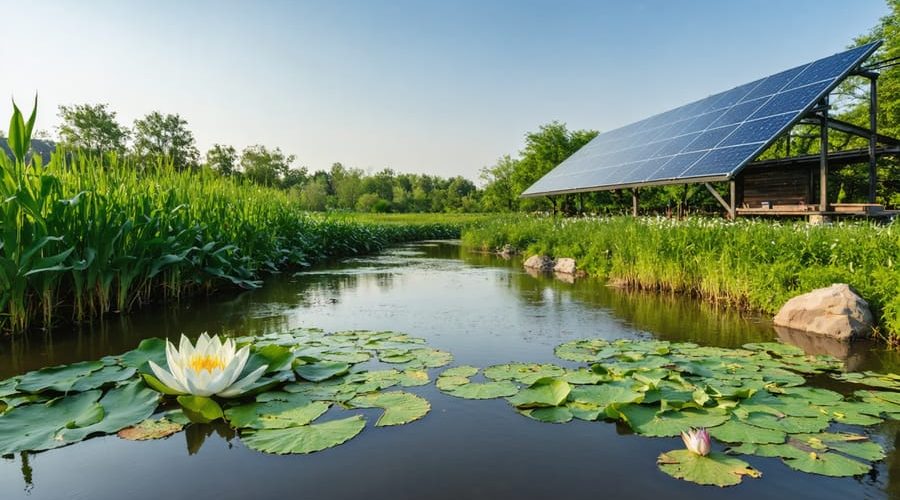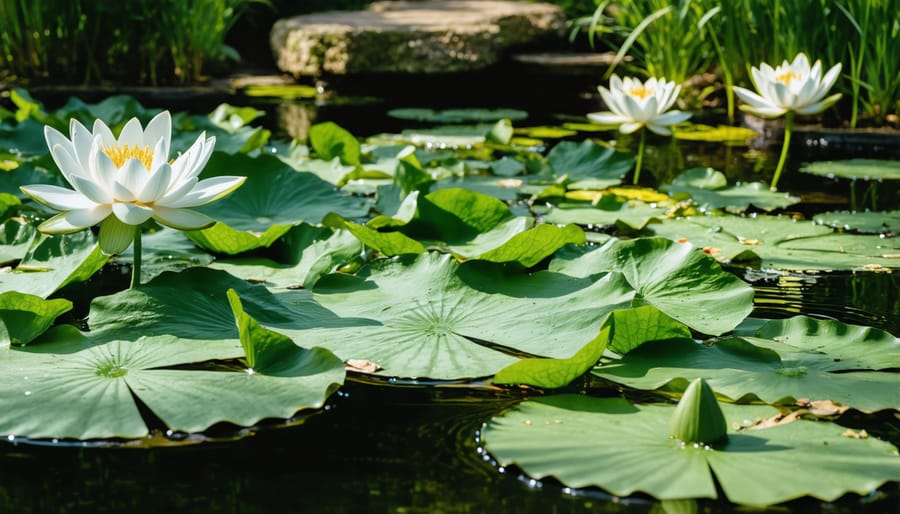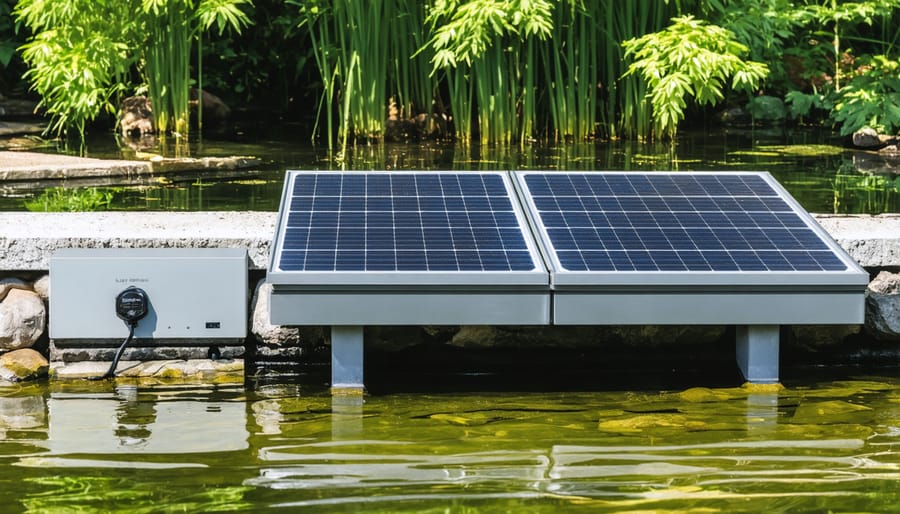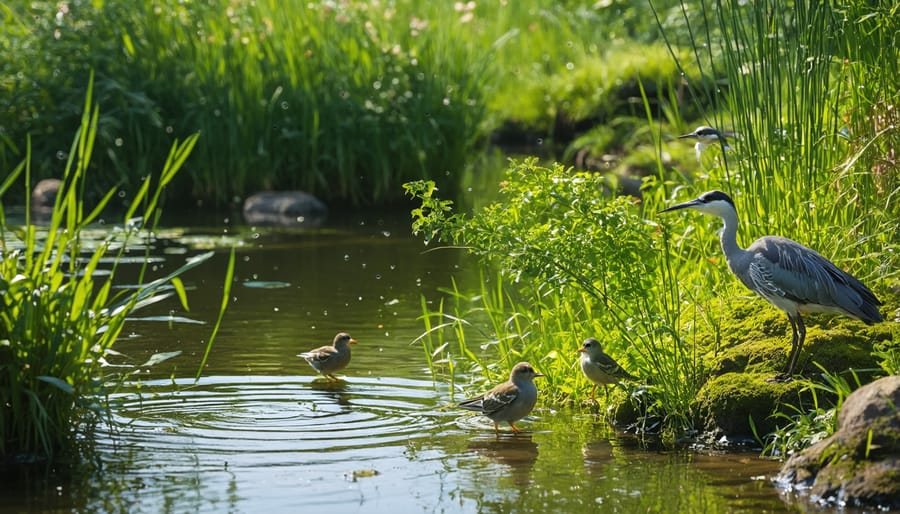
Sustainable Pond Practices That Actually Save You Time and Money
Sustainable agriculture stands at the forefront of our fight against climate change, food insecurity, and environmental degradation. Modern farmers are revolutionizing traditional practices by embracing methods that not only protect our planet but also ensure long-term productivity and profitability. From small-scale organic farms to large agricultural operations, these seven time-tested practices demonstrate how we can produce abundant food while preserving our natural resources for future generations.
These sustainable techniques work together to create resilient farming systems that reduce environmental impact while maintaining high yields. By implementing these practices, farmers can significantly lower their operating costs, improve soil health, and contribute to a more sustainable food system. Whether you’re an experienced farmer looking to transition to more eco-friendly methods or a newcomer to agriculture seeking the best starting point, these seven practices provide a solid foundation for sustainable farming success.
Natural Water Filtration Systems

Aquatic Plants as Natural Filters
Nature’s own filtration system comes in the form of beneficial aquatic plants, which play a crucial role in maintaining water quality and supporting sustainable agriculture. These plants act like living filters, absorbing excess nutrients, removing pollutants, and oxygenating water bodies naturally.
Water lilies, cattails, and rushes are particularly effective at removing nitrogen and phosphorus from water, helping prevent algae blooms that can harm crops and livestock. Duckweed, despite its small size, is a powerhouse at absorbing heavy metals and providing nutrient-rich biomass that can be used as green manure.
Installing these plants in agricultural ponds, drainage ditches, and water storage areas creates a self-sustaining ecosystem that requires minimal maintenance. They not only clean the water but also provide habitat for beneficial insects and wildlife that support natural pest control.
For best results, combine different types of aquatic plants – floating, submerged, and marginal species – to create a complete filtration system that works at various water depths. This natural approach reduces the need for chemical treatments while supporting biodiversity and water conservation efforts.
Creating a Balanced Ecosystem
Creating a balanced, self-sustaining ecosystem in your agricultural space is like conducting a symphony where every element plays its part. Start by introducing diverse plant species that work together – deep-rooted plants to prevent soil erosion, nitrogen-fixing legumes to enrich the soil, and flowering plants to attract beneficial insects. Consider creating hedgerows or buffer zones that provide habitat for natural predators like birds and beneficial insects, which help control pest populations naturally.
Incorporate companion planting strategies where certain plants benefit others when grown nearby. For example, marigolds naturally repel harmful nematodes, while basil can improve the growth and flavor of tomatoes. Maintain healthy soil biology by regularly adding organic matter and avoiding chemical pesticides that can disrupt the natural balance.
Water management is crucial – implement rainwater harvesting systems and use mulch to retain moisture. Remember to rotate crops seasonally to prevent soil depletion and disease buildup. These practices work together to create a robust ecosystem that requires minimal intervention while maximizing productivity.
Energy-Efficient Pumping Systems
Reducing energy consumption in your pumping system isn’t just good for the environment – it’s great for your wallet too! Modern energy-efficient pumps have come a long way, offering smart solutions that maintain excellent water quality while using significantly less power.
Start by selecting the right pump size for your needs. Many pond owners make the mistake of buying oversized pumps, which waste energy and money. A good rule of thumb is to circulate your pond’s entire volume once every two hours. For example, a 1,000-gallon pond needs a pump rated at about 500 gallons per hour.
Consider installing a variable speed pump, which automatically adjusts its power usage based on your pond’s needs. These smart pumps run at lower speeds during off-peak times and ramp up only when necessary, potentially reducing energy consumption by up to 80%.
Solar-powered pumps are another excellent option, especially for smaller ponds. While the initial investment might be higher, they can significantly reduce or eliminate your pump’s electricity costs. Many modern solar pumps come with backup batteries, ensuring continuous operation even during cloudy days.
Regular maintenance is crucial for energy efficiency. Clean your pump and filters monthly to prevent clogging and strain on the motor. Install a timer to run your pump only when needed – most ponds don’t require 24/7 circulation during cooler months.
Consider adding natural filtration methods like beneficial bacteria and aquatic plants to reduce the workload on your pump. This biological filtration helps maintain water quality while allowing you to run your pump less frequently.
Finally, protect your pump from debris with a pre-filter or skimmer box. This simple addition can significantly improve pump efficiency and extend its lifespan, saving both energy and replacement costs.
Rainwater Harvesting Integration
Rainwater harvesting is a game-changer for sustainable agriculture, offering a smart solution to reduce water consumption while maintaining healthy crops. By capturing and storing rainwater, farmers can significantly decrease their reliance on groundwater and municipal water sources, especially during dry seasons.
The most common method involves installing gutters and downspouts on building roofs to direct rainwater into collection tanks or cisterns. These systems can be as simple as placing rain barrels under downspouts or as sophisticated as underground storage tanks with filtration systems. For larger agricultural operations, constructing retention ponds or reservoirs helps store substantial amounts of rainwater for extended periods.
To maximize the benefits of rainwater harvesting, farmers often implement complementary practices such as:
– Installing drip irrigation systems that deliver collected rainwater directly to plant roots
– Creating swales and berms to slow water flow and increase soil absorption
– Using mulch to reduce evaporation and maintain soil moisture
– Installing overflow systems to prevent flooding during heavy rainfall
The collected rainwater can serve multiple purposes beyond irrigation, including livestock watering, greenhouse operations, and cleaning farm equipment. This versatility makes rainwater harvesting an invaluable component of sustainable farming practices.
To ensure system efficiency, regular maintenance is essential. This includes cleaning gutters, checking filters, and inspecting storage containers for potential leaks or damage. During the design phase, it’s crucial to calculate your water needs and storage capacity to create an appropriately sized system that meets your farm’s requirements while considering local rainfall patterns and regulations.

Organic Pond Maintenance
Natural Algae Control
Controlling algae growth naturally is one of the most effective natural pond solutions that promotes a healthy ecosystem. Start by introducing beneficial aquatic plants that compete with algae for nutrients. Water lilies, lotus, and floating plants like duckweed not only look beautiful but also shade the water surface, reducing sunlight that algae needs to thrive.
Consider adding barley straw to your pond, as it releases natural compounds that inhibit algae growth when it decomposes. A UV clarifier can also help control single-celled algae without harsh chemicals. Maintaining proper fish populations prevents excess nutrients from overfeeding, which can fuel algae blooms.
Regular pond maintenance, including removing dead plant material and installing a bottom aerator, helps prevent the nutrient buildup that algae thrives on. Consider introducing beneficial bacteria that naturally break down organic matter and compete with algae for nutrients. These eco-friendly methods work together to create a balanced ecosystem where algae remains under control naturally.
Beneficial Bacteria Solutions
Nature’s tiniest helpers play a massive role in sustainable agriculture through beneficial bacteria solutions. These microscopic organisms work tirelessly to break down organic matter, maintain soil health, and improve water quality in agricultural systems. By introducing specific bacterial strains, farmers can naturally purify water, reduce harmful algae growth, and create a balanced ecosystem that supports healthy crop growth.
These beneficial bacteria work by consuming excess nutrients, particularly nitrogen and phosphorus, which would otherwise lead to water pollution and algal blooms. They also help decompose organic waste, turning it into valuable nutrients that plants can use. This natural process reduces the need for chemical treatments and creates a self-sustaining system that’s both cost-effective and environmentally friendly.
To implement beneficial bacteria solutions, farmers can add specialized bacterial products to irrigation systems, water storage tanks, or directly to the soil. Regular applications, especially during warmer months, help maintain a healthy bacterial population that continuously works to improve water quality. This approach not only supports cleaner water but also enhances overall farm sustainability by reducing chemical inputs and promoting natural biological processes.
Fish Stock Management
Proper fish stock management is essential for creating a sustainable pond ecosystem that thrives without constant intervention. The key lies in maintaining healthy fish populations while ensuring your pond can naturally support them.
Start by calculating your pond’s carrying capacity – a general rule of thumb is one inch of fish per 10 gallons of water. This prevents overcrowding and reduces the strain on your pond’s ecosystem. When stocking fish, choose species that complement each other and serve different roles in the pond’s food chain.
Consider implementing a natural feeding program that combines commercial fish food with naturally occurring food sources. Encourage the growth of beneficial aquatic plants that provide shelter and sustenance for your fish. Water plants like duckweed and water lilies not only offer natural food but also help maintain water quality.
Create zones within your pond where fish can find shelter and reproduce naturally. Underwater structures like rock formations or carefully placed logs provide safe spaces for smaller fish and help maintain population balance. Regular monitoring of fish behavior and growth helps you adjust feeding schedules and identify potential issues before they become problems.
Remember to introduce new fish gradually and quarantine them before adding them to your main pond. This practice prevents the spread of diseases and allows new fish to acclimate properly. By following these sustainable stocking principles, you’ll create a balanced ecosystem that requires minimal intervention while supporting a healthy fish population.
Water Conservation Techniques
Water conservation is at the heart of sustainable agriculture, and implementing effective techniques can dramatically reduce water waste while maintaining optimal crop health. One of the most impactful methods is drip irrigation, which delivers water directly to plant roots, reducing evaporation and ensuring up to 90% water use efficiency compared to traditional sprinkler systems.
Farmers can also employ soil moisture sensors and weather monitoring systems to make data-driven irrigation decisions. These tools help determine exactly when and how much water crops need, preventing both under and over-watering. Mulching is another valuable technique that helps retain soil moisture, reduce evaporation, and suppress water-hungry weeds.
Rainwater harvesting systems can capture and store precipitation for later use, providing a sustainable water source during dry periods. This can be as simple as installing rain barrels or as sophisticated as creating large-scale collection ponds. Water recycling systems can also be implemented to treat and reuse agricultural runoff and processing water.
Drought-resistant crop varieties and climate-appropriate planting schedules help minimize water requirements naturally. By selecting plants that thrive in local conditions and timing plantings to coincide with natural rainfall patterns, farmers can significantly reduce irrigation needs.
Maintaining soil health through organic matter addition improves water retention capacity. Healthy soils with high organic content can hold more water and release it slowly to plants, reducing the frequency of irrigation needed. This approach, combined with conservation tillage practices, helps create a more water-efficient agricultural system while promoting long-term sustainability.

Wildlife-Friendly Design
Creating a farm environment that can support local wildlife is crucial for maintaining ecological balance and enhancing natural pest control. Start by establishing buffer zones around fields using native plants and flowering species that attract beneficial insects and pollinators. These areas serve as natural corridors for wildlife movement and provide shelter for helpful predators like birds and beneficial insects that naturally control pest populations.
Consider incorporating hedgerows and windbreaks using local tree species, which not only protect crops from harsh weather but also create nesting sites for birds and small mammals. Maintain existing water features or create new ones, such as small ponds or wetland areas, which provide drinking water for wildlife and habitat for amphibians that help control insect populations.
Leave some areas of your land intentionally unmowed or wild to create natural habitats. These spaces can include rock piles for reptiles, fallen logs for insects, and dense vegetation for ground-nesting birds. During harvest, consider leaving some crop residue in fields to provide food and shelter for wildlife during winter months.
Remember to minimize the use of harmful pesticides that could affect beneficial species. Instead, focus on integrated pest management strategies that work in harmony with natural predator-prey relationships. This approach not only helps protect wildlife but also contributes to more resilient and productive farming systems.
By implementing these sustainable pond practices, you’ll create a thriving ecosystem that practically maintains itself while benefiting the environment and your wallet. These methods work together to reduce maintenance time, lower operating costs, and create a more natural, self-sustaining water feature that you can enjoy for years to come.
Remember, sustainable pond keeping isn’t just about being eco-friendly – it’s about working smarter, not harder. When you embrace these practices, you’ll spend less time maintaining your pond and more time enjoying it. Your pond will become a vibrant habitat for local wildlife, help conserve water resources, and serve as a beautiful example of how sustainability and aesthetics can go hand in hand.
Start implementing these practices gradually, and you’ll soon notice the positive changes in your pond’s health, appearance, and overall maintenance needs. Whether you’re a beginner or experienced pond keeper, these sustainable methods will help you create a more resilient and environmentally responsible water garden that brings joy to both you and the ecosystem around it.
